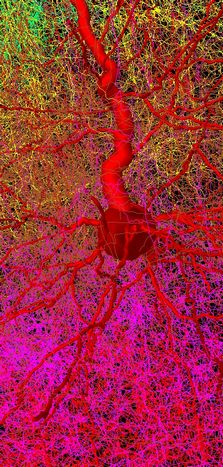- Home
- Who-is-Who
- Workshops
- Big Data in Electrophysiology
- Personalized health care workshop
- NeuroImaging Data
- Neuroinformatics congress 2015
- Atlasing workshop
- Neuroinformatics2014
- Cortical activity patterns
- Population Neuroimaging
- Image Analysis
- Imaging Summerschool Antwerp
- Predictive Neuroinformatics
- Neurotechnology Symposium
- Data sharing workshop
- Neural Systems modeling
- Donders Connectomes workshop
- Clinical Applications workshop
- Brain-inspired computing
- Dendrites workshop
- Share and Flourish
- Symposium 2011
- Calendar
- Companies
- Software & Services
- About / Mission
Workshop Predictive Neuroinformatics
Date:
May 24th, 2013
Time:
13:30 - 17:00, followed by drinks
Place:
Radboud Universiteit Nijmegen, Thomas van Aquinostraat 8, 6525 GD (Spinozagebouw: from Nijmegen station bus 3,11,12,13 halte Spinozagebouw), zaal 8.00.13.
Registration:
registration page (max. 60 participants)
Organizer: NeuroInformatics.NL; program committee Rembrandt Bakker, Marcel van Gerven, Paul Tiesinga
Time:
Place:
Registration:
Organizer: NeuroInformatics.NL; program committee Rembrandt Bakker, Marcel van Gerven, Paul Tiesinga
Predictive neuroinformatics concerns the development of validated statistical models that predict features of the brain that have not yet been measured experimentally to the required extent or level of detail. Typically these models use existing (sparse) experimental data at different levels of biological organization. Multi-modal, multi-scale data integration is one aspect of predictive neuroinformatics; another pillar is formed by using constraints imposed by generative (neural growth) models.
 Program
Program
| 13:30 | Doors open and coffee | |
| 13:40 | Marcel Oberlaender (Max Planck Inst. Tübingen) |
Simulation of sensory-evoked signal flow in anatomically realistic 3D reconstructions of rat cortex abstract Soma location, dendrite morphology and synaptic innervation are key determinants of neuronal function. Unfortunately, conventional functional measurements of sensory-evoked activity in vivo yield limited structural information. In particular, when trying to infer mechanistic principles that underlie perception and behavior, interpretations from functional recordings of individual or small groups of neurons often remain ambiguous without detailed knowledge of the underlying network structures. I will present a novel reverse engineering approach that allows investigating sensory-evoked signal flow through individual and ensembles of neurons within the context of their surrounding neural networks. To do so, spontaneous and sensory-evoked activity patterns are recorded from individual neurons in vivo. In addition, the complete 3D dendrite and axon projection patterns of such in vivo characterized neurons are reconstructed using a custom-designed semiautomatic tracing pipeline. Our semiautomatic tracing system rivals manual tracings from human experts in both accuracy and completeness. Specifically, the combination of these in vivo filling and reconstruction approaches recovered total axonal lengths far greater than previously observed. For example, intracortical axonal lengths of most pyramidal neurons in rodent sensory cortex exceed 10 centimeters per neuron. The axon of an individual thalamocortical neuron can even reach a length of up to 25 centimeters. Finally, the hence reconstructed neurons are integrated into an anatomically realistic cortex model, which is based on high-resolution reconstructions of the cortex geometry, large-scale neuron counts and structural overlap between axons and dendrites. The model allows estimating the number and cell type-specific subcellular distribution of synapses. As a result, each neuron can be described by a rich set of parameters that allows investigating structure-function relationships and simulation experiments at single neuron and network levels. |
| 14:20 | Marcel van Gerven (Radboud Univ. Nijmegen) |
Bayesian Connectomics abstract Connectivity analysis is becoming increasingly important in cognitive neuroscience. Various methods have been developed to estimate structural and functional brain networks and these networks can be used to predict various aspects of human cognition. However, at present, structural and functional connectivity estimation ignores uncertainty in the estimates. In this talk, I will present our recent work on Bayesian methods that do allow quantification of this uncertainty. I refer to this research line as Bayesian connectomics. The Bayesian connectomics framework makes use of generative models that explain observed neuroimaging data as acquired by different imaging modalities. As such, Bayesian connectomics provides an elegant theoretical framework for structural and functional connectivity analysis, similar in spirit to what dynamic causal modeling has done for effective connectivity analysis. |
| 15:00 | Coffee break | |
| 15:20 | Markus Axer (Forschungszentrum Jülich) |
JuBrain – Towards a multi-modal and multi-scale model of the human brain abstract In order to understand the organization principles of the human brain at the level of the underlying anatomical structures, post mortem brain studies are of particular importance. Recent developments in the field of microscopic neuroimaging in terms of technology and resolution open up new avenues to obtain information about the brain that was not available so far, but they also push the manageability of data sets to the limits. At the Institute of Neuroscience and Medicine (INM-1), Research Center Jülich, Germany, different types of post mortem studies are being performed aiming for a comprehensive multi-modal 3D model of the human brain – the JuBrain. The obtained post mortem data reflect the cyto architecture, the receptor architecture and the fiber architecture in distinct brains utilizing different imaging techniques. Most of our studies require the brains to be cut into thousands of thin histological sections. Typical section thicknesses cover the range between 10 microns and 60 microns, which translates into 15.000 and 2.500 sections per human brain that need to be measured one by one and finally reconstructed (re-aligned) into a coherent 3D brain volume. In my talk, I will present our recent work on cyto and fiber architecture, which includes the development of a neuroimaging technique based on polarized light (PLI) providing high-resolution information about local fiber (tract) orientations. In this context, some of the main challenges of modern anatomical brain research will be addressed. |
| 16:00 | Hermann Cuntz (Ernst Strüngmann Inst. Frankfurt) |
Provisional title: How single cell wiring rules impact the formation of larger neural circuits |
| 16:40 | Paul Tiesinga (Radboud Univ. Nijmegen) |
Discussion "Potential applications of predictive modeling". |
| 17:00 | Drinks | |
Date/period:
Friday, May 24, 2013 - 13:30
Location:
Nijmegen
Date status:
Fixed
Organizer:
NeuroInformatics.NL




